ANNA CLYNE [UK] >>>
Anna Clyne holds a first-class Bachelor of Music degree with honors from Edinburgh University and a Master of Music degree from the Manhattan School of Music. She currently resides in New York. Her music is published by Boosey & Hawkes.
ARTISTIC STATEMENT
My passion is collaborating with innovative and risk-taking musicians, film-makers, visual artists and, in particular, choreographers. Creating new works through a fluid artistic dialogue has consistently fuelled my art-form from new perspectives and has maintained a fresh and exciting creative environment. Inspired by visual images and physical movement, my intention is to create music that complements and interacts with other art-forms, and that impacts performers and audience.
STEWART COLLINSON [UK] >>>
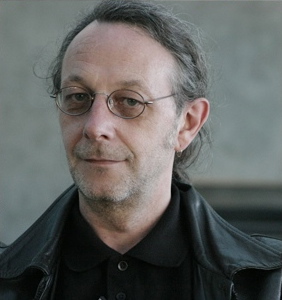 |
His interest in moving
image is principally informed by the body of
work created by artists, whose concerns are
not narrative or documentary. As the moving
image became appropriated by storytellers and
conveyers of ideology and information in the
early part of the 20th Century, these visual
artists sought to use the medium for other
purposes. Having dispensed with narrative as
a means of structuring time, many turned to
music as the model to organise the duration
of this new visual time-based medium.
Explored in this way, the moving image
becomes a more abstract potential, freed from
the structure of representation, concerned
instead with the materiality of the medium;
light and darkness, colour, movement and
rhythm. Current and emergent digital
technologies and software offer the artist
the possibility of blurring the boundaries
between existing art-forms even further.
His work covers a range of activities: as an artist making moving image work for single-screen viewing, gallery installation and live performance: as a facilitator of arts education project work with regional, national and international arts organisations in collaboration with composers, musicians and dancers. The outcomes of these projects can also be work for single screen, multi-screen installation or live mixing and projection of video and digital imagery for performance. European Bridges Ensemble (EBE), member since 2006. Senior Lecturer in Moving Image at the School of Art, Lincoln University, UK. |
NICK DIDKOVSKY [USA] >>>
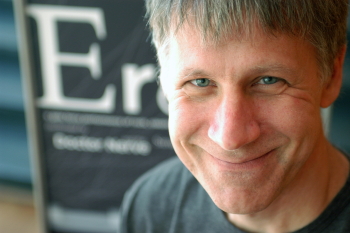 |
is a guitarist, composer, band leader, and software programmer. In 1983, he founded the avant-rock octet Doctor Nerve. He presently resides in New York City, where he composes, creates music software, and teaches computer music composition at New York University and Columbia University. He is the principle author of the computer music language Java Music Specification Language (www.algomusic.com). He has composed music for Bang On A Can All-Stars, Meridian Arts Ensemble, Fred Frith Guitar Quartet, California EAR Unit, New Century Players, Ethel String Quartet, Electric Kompany, ARTE Quartett, and other ensembles. His Punos Music record label offers CD releases of his more extreme musical projects. He is director of bioinformatics for the Gensat project at The Rockefeller University. |
| Didkovsky's work with
Doctor Nerve joins the furious energy of
rock with intricate composition, some of
which finds its origins in rich software
systems of his own design. His
non-didactic approach to combining human
and machine creativity is his unique
fingerprint in a musical world that
pushes the boundaries of rock music,
algorithmic composition, and contemporary
music. Doctor Nerve has performed at a
number of music festivals, including the
Composers' Showcase at The Whitney Museum
of American Art, FIMAV Festival
(Victoriaville, Quebec), MIMI Festival
(Arles, France), Creative Time (Brooklyn
Bridge Anchorage), Rumor Festival
(Holland), Moers Festival (Germany),
Festival Musique Actuelle (Victoriaville,
Canada), and Festival des Musiques
Innovatrices (France). In 1995 Didkovsky
released a score book containing full
ensemble scores for all the compositions
from the CD "SKIN".
Didkovsky is a member of the Fred Frith Guitar Quartet, which to date has released two CD's, entitled Ayaya Moses and Upbeat (Ambiances Magnetique). Didkovsky has contributed twelve compositions to the ensemble. His new trio Bone with bassist Hugh Hopper (ex Soft Machine) and drummer John Roulat released their first record on Cuneiform Records. The CD features intricate, high energy compositions and improvisation. Bone recently enjoyed its premiere performance at "December 2006 at The STONE" curated by Bruce Gallanter, and in 2008 performed at The Whitney Museum of American Art. With Phil Burk, Didkovsky created Java Music Specification Language (JMSL), a language for computer music composition written in the Java programming language. JMSL was premiered at Circuits: The Governor's Conference on Arts and Technology, in Palisades, NY in March, 1998. In 2003, Minnesota Public Radio commissioned Didkovsky to design a JMSL version of the Rhythmicon, an electronic musical instrument originally designed by Henry Cowell and Leon Theremin in 1930. It is hosted at www.musicmavericks.org/rhythmicon and was featured on The Art of the Virtual Rhythmicon (Innova , 2006). Didkovsky has presented papers on JMSL at three International Computer Music Conferences (2001, '04, '06), & the JavaOne Conference (2003). Didkovsky has received commissioning grants from The Mary Flagler Cary Charitable Trust, Meet the Composer's Commissioning/Music USA, the Jerome Foundation, and numerous privately funded initiatives. He has received recording grants from The Mary Flagler Cary Charitable Trust and the Aaron Copland Fund. He was awarded a New York Foundation for the Arts Computer Arts Fellowship to support his work in computer music composition and performance. His Black Sabbath Guitar Lessons on YouTube have been received with great enthusiasm by metal fans all over the world. |
|
EUROPEAN BRIDGES ENSEMBLE [EU] >>>
In 2009 July the ensemble worked at Hochschule für Musik und Theater Hamburg together with four young composers to create new network pieces. The result will be presented at MNW2009.
http://e-b-e.eu/
JASON FREEMAN [USA] >>>
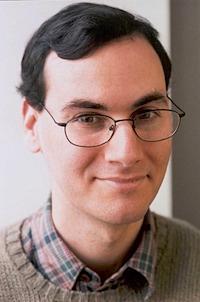 |
Jason Freeman’s works break down
conventional barriers between composers,
performers, and listeners, using
cutting-edge technology and unconventional
notation to turn audiences and musicians
into compositional collaborators.
|
| Freeman’s works have been featured in The New York Times, on National Public Radio’s All Things Considered, and online at USA Today, Wired, and Billboard, which called Network Auralization for Gnutella (N.A.G.) “an example of the Web’s mind-expanding possibilities.” They have been exhibited and performed at the NTT InterCommunication Center (Tokyo), the Viper Festival (Basel), Donnaueschinger Musiktage (Germany), the Boston CyberArts Festival, the Transmediale Festival (Berlin), 01SJ (San Jose), Filmwinter (Stuttgart), and the Lincoln Center Festival (New York). His instrumental compositions have been performed by groups ranging from the American Composers Orchestra, Le Nouvel Ensemble Moderne, the Nieuw Ensemble, and Speculum Musicae to the Rova Saxophone Quartet, the So Percussion Group, and an elementary school band, chorus, and orchestra in Richmond, Virginia. He has received awards and grants from ASCAP, the American Music Center, Meet the Composer, the Yvar Mikhashoff Foundation, and Akademie Schloss Solitude. Freeman has also published articles about his work in Computer Music Journal, Leonardo, Organised Sound, and the Journal of New Music Research. | |
http://www.jasonfreeman.net/
FRANK GRATKOWSKI [GER] >>>
| Born in Hamburg, 1963.
Started playing the saxophone at 16 and, following a period at the Hamburg Conservatory (Hamburger Musikhochschule), moved in 1985 to study at the Cologne Conservatory of Music with Heiner Wiberny, graduating in 1990. Further studies with Charlie Mariano, Sal Nistico and Steve Lacy. Frank Gratkowski has been working as a soloist in various international formations (Grubenklang Orchester, Klaus Koenig Orchester, Musikfabrik NRW, Tony Oxley Celebration Orchestra, Bentje Braam, BikBentBraam, All Ears, Zeitkratzer, WDR Big band, etc.). |
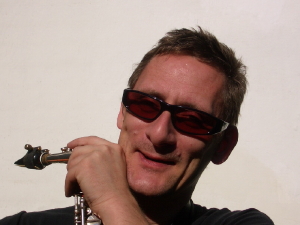
Frank Gratkowski |
| Since 1990 he has been
giving solo performances throughout
Europe, Canada and USA. With his first
solo program, he was a 1991 prizewinner
in the Musik Kreativ contest. The release
of the solo CD "Artikulationen"
followed the same year and a new one
"Artikulationen II" in
2002. Since 1992 he has been working in a
duo with the pianist Georg Graewe (CD
"VicissEtudes"). The duo is often extended
through the participation of different
additional musicians, such as drummer Paul
Lovens (CD "Quicksand") and
bassist John Lindberg (CD "Arrears").
In 1995 he founded the "Frank Gratkowski Trio" with Dieter Manderscheid (Germany), bass, and Gerry Hemingway (USA), drums, (CDs "Gestalten" and "The Flume Factor" ). In 2000 the trio has been extended to a quartet quartet by Dutch trombonist Wolter Wierbos (CDs "Kollaps", "Spectral Reflections" and "Facio"). Since 2003 also appearing as a Double Quartet plus Tobi Delius, Herb Robertson, Wilbert DeJoode and Michael Vatcher. In 2005 he got the SWR Jazzprize. In 1999 the duo with the Italian trombonist Sebastiano Tramontana has been formed and since 2001 Frank Gratkowski has been performing with a trio including Wilbert De Jode (NL) on bass and Achim Kaufmann (D) on piano (CDs "Kwast" and "Unearth"). Frank Gratkowski played on nearly every German and on numerous international Jazz Festivals including Vancouver, Toronto, Chicago, New York, Seattle, Quebec, Les Mans, Muelhuus, Groeningen, Nickelsdorf, Barcelona, Lithuania, Warsaw, Zagreb, Prague, Bratislava, Sofia, Bucharest, Odessa and Roma. |
|
| He has been teaching
saxophone and ensembles at the Cologne,
Berlin and Arnhem Conservatory of Music
and is giving workshops all around the
world as well.
Furthermore he has performed with Robert Dick, Phil Wachsmann, Radu Malfatti, Herb Robertson, Marcio Mattos, Eugenio Colombo, Peter Kowald, Ray Anderson, Michael Moore, Ken Vandermark, Greg Osby, Kenny Wheeler, Louis Sclavis, John Betsch, Jane Ira Bloom, Connie and Hannes Bauer, Xu Fengxia, James Newton, Muhal Richard Abrams, John Lindberg, Michael Formaneck, Ernst Reijseger, Fred van Hove, Theo Jörgensmann, Phil Minton, Peter Brötzmann, Mark Dresser, Mark Feldman, Hamid Drake, Michiel Braam, Han Bennink, Mal Waldron, Misha Mengelberg a.m.o. |
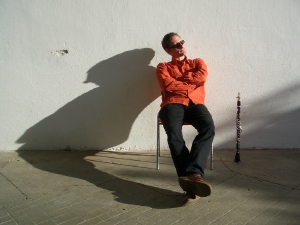
Frank Gratkowski |
http://www.gratkowski.com/
DANIEL IGLESIA [BR] >>>
He is currently a Teaching Fellow at the Columbia Computer Music Center. This spring, he will be a Visiting Lecturer at Princeton University.
http://music.columbia.edu/~daniglesia/
JOHANNES KRETZ [A] >>>
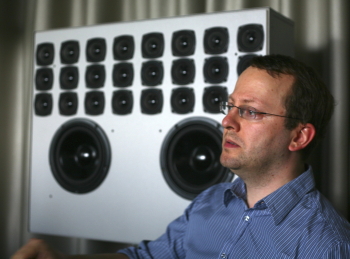 |
Born 1968 in Vienna,
studies (composition, pedagogy) at the music
academy Vienna with F. BURT and M. JARRELL
and mathematics at the University Vienna
1992/93: studies at IRCAM, Paris with Marco Stroppa and Brian Ferneyhough co-founder of the NewTonEnsemble, of the international composers group PRISMA and of www.ikultur.com teacher for music theory and composition at the conservatory of Vienna 1996-2001: teacher for for computer music at the academy in Vienna, since 2001 also music theory, since 2004 also composition, since 2009: habilitation in composition, associate professor ("Privatdozent") Since 2008: Head of the ZiMT ("center for innovative music technology") of the music university Vienna performances in Austria, Germany, France, Poland, Hungary, Turkey, Lithuania, Czechia, Argentina, Mexico, Kanada, Taiwan and South Korea regular broadcasts in Austrian and German radio commissions of works from Konzerthaus Wien, Klangforum Wien, Ensemble On Line, Vienna Flautists, quartett22, Internationale Lemgoer Orgeltage, Haller Bachtage, Triton Trombone Quartett, Wiener Kammerchor numerous grants and prizes |
| In the works of Johannes
Kretz a lot of attention is given to the
shaping of timbre and harmony , to
achieve a unification of them. Sounds are
interpreted as chords, chords fused to
let them appear as sounds.
Unterstanding of psychoacoustic effects and the ability of describing and formalizing ideas of art has helped to develop a new craftmanship in composition. This skills and techniques can also be found in Johannes Kretz' purely instrumental works. So he succeeds in creating a strange - but wonderfully sturctured - world of sound, that invites the listener to find shapes in the area of timbre, which one was only used to find in the area of harmony before. |
|
http://www.johanneskretz.com/
ANDREA LADÁNYI [H] >>>
From 1981-86 she was the Solo dancer of The Győri Ballet Company led by the choreographer Iván Markó. Between 1986-89 she trained in ballet, modern and jazz dancing in Toronto, New York, Los Angeles and between 1989-91 was the solo dancer of the Helsinki City Theatre and untill 1992, the Finnish National Opera.
In 1995 Founded and leads her own company the La dance company. In 2002 she was appointed Chair of the Movement Department at the Hungarian National Academy of Film and Theatre . In 2005 graduated from the Hungarian National Academy of Film and Theatre as director-choreographer. She has participated in several TV and Film productions.
Amongst ohers her work was acknowledged by the Franz Liszt Award and she is a Merited Artist of the Hungarian Republic.
MERZBOW (MASAMI AKITA) [J] >>>
| Merzbow
(メルツバウ
Merutsubau) is a noise project created
in Tokyo, Japan in 1979 under the direction
of noise technician Masami Akita
(秋田
昌美
Akita Masami). Since 1979, he has
formed two record labels and has contributed
releases to numerous independent record
labels. As well as being a prolific artist,
he has also written a number of books and has
been the editor of several magazines in
Japan. He has written about a variety of
subjects, mostly about art, avant-garde and
post-modern culture. His more renowned works
have been on the topics of BDSM and fetish
culture. Other artforms Akita has been
interested in include directing and Butoh
dance.
The name "Merzbow" comes from German artist Kurt Schwitters' artwork, Merzbau. This was decided upon to reflect Akita's dada influence and junk-art aesthetic. In addition to this, Akita has cited a wide range of influences from various progressive rock artists such as Frank Zappa and King Crimson to Japanese bondage. In 2000, Extreme Records released the 50 CD box set known as the Merzbox. Since 2004 he has been a supporter of PETA (People for the Ethical Treatment of Animals) which has influenced a number of animal-themed releases as well as Akita becoming vegan. Akita's work has been the subject of several remix albums and at least one tribute album. Akita is prolific and has produced over 200 releases since 1980. This, among other achievements, has helped Merzbow to be regarded as the "most important artist in noise". |
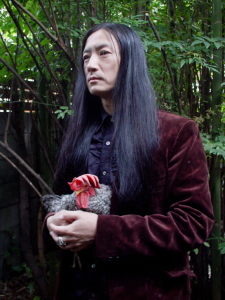
MERZBOW (Masami Akita) |
Growing Up Masami Akita was born in Tokyo in 1956. He listened to psychedelic music, progressive rock, and later free jazz in his youth, all of which have influenced his noise. In high school he became the drummer of various high school bands which he left due to the other members being "grass-smoking Zappa freaks". By this time he and high school friend Kiyoshi Mizutani had started playing improvised rock at studio sessions which Akita describes as "long jam sessions along the lines of Ashra Tempel or Can but we didn't have any psychedelic taste". He later attended Tamagawa University to study fine art from which he majored in painting and art theory. While at university he became interested in the ideas of dada and surrealism and also studied Butoh dance. This is where he learned of Kurt Schwitters' Merz, or art made from rubbish, including Schwitters' Merzbau, or "Merz building" which is the source of the name "Merzbow". Lowest Music & Arts (1979–1984) Merzbow began as the duo of Masami Akita and Kiyoshi Mizutani who met Akita in high school. He started releasing noise recordings on cassettes through his own record label, Lowest Music & Arts, which was founded in 1979 in order to trade cassette tapes with other underground artists. The first tape made for the label was Metal Acoustic Music and was sold exclusively by mail order. Various other releases were made before the first real release which included Collection Era Vol. 1 and a very limited release of Remblandt Assemblage. The Collection Era series was originally ten cassettes that were going to be distributed through an independent label called YLEM but when it became defunct and cancelled the series, Akita decided to release them through Lowest Music & Arts. His earliest music was made with tape loops and creatively recorded percussion and metal. "I threw all my past music career in the garbage. There was no longer any need for concepts like 'career' and 'skill'. I stopped playing music and went in search of an alternative." - Masami Akita on Lowest Music & Arts. Early methods included what he referred to as "material action", in which he would closely amplify small sounds so as to distort them through the microphone. The early releases were photocopies of collages made out of manga and porn magazines he found in trash cans in the Tokyo subway. Akita explained this as trying to "create the same feeling as the secret porn customer for the people buying my cassettes in the early '80s". In 1984 he founded a second record label called ZSF Produkt. ZSF Produkt (1984–1990) ZSF Produkt was founded in 1984 to release music by similar artists within the industrial movement but eventually became the successor to Lowest Music & Arts. Numerous releases were made in the ZSF Produkt studio with Mechanization Takes Command being the first. The studio continued to be used until 2001 when Akita started producing home recordings from his bedroom studio. During this era, Merzbow found much wider recognition and began making recordings for various international labels. He also started touring abroad with the help of various collaborators. Merzbow toured USSR in 1988, USA in 1990, Korea in 1991 and Europe in 1989 and 1992. For most of the late 1980s through the 1990s, Merzbow live was a trio including Reiko A. on electronics and Bara on voice and dance. Around this time he started crediting the name "Abtechtonics" (or variations of this) on his recordings under artwork. He explained in the Merzbook that this name is used for him publishing his own artwork which he attempts to do as much as possible. Digital era (1990–2000) Merzbow's first digital recording was the CD release Cloud Cock OO Grand in 1990. With a higher international profile in the 90's, Merzbow started working on more ambitious projects such as the Noisembryo, which was a Merzbow album sealed in a car released in a limited edition of one copy. The disc was sealed in the CD player of a BMW sedan which was rewired to play the cd whenever the car was started. The CD was also released normally on the same label. Recordings from the mid-1990s onwards are mostly of extreme volume, some mastered at levels far beyond standard (Noisembryo, Pulse Demon). From 1996, plans were made to release a "10 (or maybe 12)" CD box set on Extreme Records. In 2000, Extreme Records released the Merzbox, a fifty CD set of Merzbow records, twenty of them not previously released. Laptop era (2000–present) Since 2000, Akita began to use computers more in his recordings. At live performances, Akita has produced noise music from either two laptop computers or combination of a laptop and analog synthesizers. Reiko Akita, formerly Reiko Azuma, left Merzbow during this time and now has a solo career. Since 2001, Jenny Akita (formerly Kawabata) started being credited for artwork on various releases. Since 2001, Akita started utilising samples of animal sounds in various releases starting with Frog. Akita has also been a supporter of PETA (People for the Ethical Treatment of Animals) which is reflected in his animal-themed releases. An example of this is Minazo Vol. 1 and Vol. 2, dedicated to an elephant seal he visited often at the zoo and Bloody Sea, a protest against Japanese whaling. He has also produced several works centered around recordings of his pet chickens (notably Animal Magnetism and Turmeric). In 2002, Akita released Merzbeat, which was seen as a significant departure from his trademark abstract style in that it contains beat-oriented pieces. This has sparked some controversy among fans, though some reviewers pointed out that it sounded very similar to Aqua Necromancer (1998) which features samples of progressive rock drumming. Merzbird (2004) and Merzbuddha (2005) followed in a similar vein with sampled beats combined with Merzbow's signature harsh noise. On 2009, Akita released a 13 CD box-set called 13 Japanese Birds, a set which is released monthly (one album a month). This release features the return of Akita to the usage of analog sounds and also the use of drum kits. Also in that year Merzbow cancelled his tour over United States and Canada due to the swine flu outbreak. Side projects In addition to his solo work, Akita has been involved in a number of side-projects and supergroups since the early 80s. Tibeta Ubik and Merzbow/Null were active during this time and made several cassette releases. Bustmonster, Flying Testicle and Sponge were noise supergroups active during the 90s and usually included Yamazaki Maso of Masonna and members of Hijokaidan. SCUM was a side-project where Akita took older recordings and cut them up until they resembled a new one. SCUM was an acronym for Scissors for Cutting Up Merzbow, a reference to the SCUM Manifesto, "Society for Cutting Up Men". Akita released three albums under the SCUM name, which have all been rereleased as part of the Merzbox. Maldoror was used for releases involving a collaboration between Akita and Mike Patton from Faith No More, Mr. Bungle and various other bands. Zbigniew Karkowski, another experimental artist, also collaborated with Akita during the 90s and made several releases under the MAZK name. Recently, Akita has been collaborating with the Japanese metal band Boris and has been releasing records as Boris With Merzbow. The most recent side-project is Kikuri, a collaboration with Keiji Haino. The first Kikuri album was released in early 2008. Akita is also collaborating with Montreal experimental metal group Menace Ruine. |
|
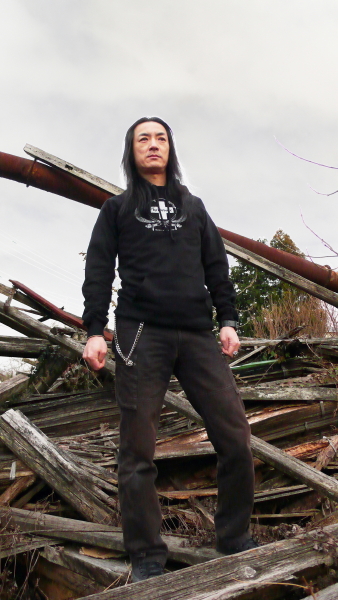
MERZBOW (Masami Akita) |
Musical style Merzbow's music employs the sounds of distortion, feedback, and sounds from synthesizers, machinery, and home-made noisemakers. While much of Merzbow's output is intensely harsh in character, Akita does occasionally make forays into ambient music. Vocals are employed sometimes, but never in a lyrical sense. Contrary to most harsh noise music, Akita also occasionally uses elements of melody and rhythm. Akita's early work consisted of industrial noise music made from tape loops and conventional instruments. Similar to his present albums, he produced lengthy, disorientating pieces. He also became infamous for the sheer amount of releases in a short time frame. Audiences in general did not quite know what to make of his style. During his tour of the USSR, he was asked to play "more musically" so on the second day of the concert he toned it down a bit. This was released as "Live In Khabarovsk, CCCP (I'm Proud By Rank Of The Workers)" and as disc 26 of the Merzbox. During the 90s Akita's work became much harsher and were generally mastered at a louder volume than usual. These were heavily influenced by black metal bands of the time (a prime example is the "Venereology" album). The mid-90's saw Akita being heavily influenced by psychedelic bands and this was reflected in various albums. Akita also did a collaboration with Gore Beyond Necropsy. The collaboration was know as Rectal Anarchy. The album consisted of short noise blasts. After 2000, Akita started making vague concept albums and experimented with sampling rhythms. He also switched from analogue synthesisers to laptops which made most of his early post-2000 albums sound colder than the previous ones and this drew some criticism from fans who preferred his previous style. Writing After completing his degree, Akita became the editor of various magazines in Japan. He frequently writes on a variety of topics such as sexuality (including pornography, S&M, and Japanese bondage. Excerpts appear in the Music for Bondage Performance album notes), underground and extreme culture (including music and art), architecture, and animal rights. He is a prolific writer and has written many books and countless magazine articles. None have been published in English. |
|
| source:
http://en.wikipedia.org/wiki/Merzbow (November 11. 2009.) |
||
http://merzbow.net/
FREDRIK OLOFSSON [S] >>>
BALÁZS PÁNDI [H] >>>
His restless and adventurous spirit has lured him into a never-ending stylistic journey. From punk/HC, grindcore, stoner metal, he has rock-drummed them all ( he even got asked by bands, like UK grindcore pioneers Extreme Noise Terror, and LA based punk/metal band Amen to join them as a full time member ). But he has also ventured well beyond the limits of the guitars-bass-drums band setting: in the last couple of years he’s been - successfully - testing the waters of improv jazz and contemporary music, and even more significantly, he’s been getting very much into today’s experimental electronic music, recording for the most respected producers these days.
His most recognised and famed - ongoing - collaboration is with breakcore’s genius figurehead Aaron Funk aka Venetian Snares with whom Balazs has been making music since 2006. Their musical relationship extends from recording and writing tracks together to VS sampling the already recorded drumming of Balazs on his recent tunes.
Balazs’s musical other half is Otto von Schirach (who made a name for himself as Skinny Puppy’s producer): the two have been playing live shows together since 2006. On their last British tour they were invited by none other than Aphex Twin and played for 5,000 people in Manchester. Also in 2008 they headlined the biggest tent Dour Festival in Belgium playing to a massive crowd of 10,000. Their first studio collaboration is scheduled late 2010. (A video report available online covering their now infamous show at Sziget Festival in Budapest, Hungary - the biggest summer music festival in Europe - has generated more than 80,000 views making it the online tv channel’s most popular clip.
His recent works include collaborations with Steven Ellison aka Flying Lotus, for his forthcoming full lenght on Warp Records, and a new band called the Blood of Heroes including Bill Laswell, Justin Broadrick ( Jesu, ex-Godflesh ), End.user, Submerged, Dr. Israel.
He is also a member of To Live And Shave In LA, a loose collective of musicians established in 1991, having included members as diverse as Andrew WK, Tom Smith ( ex-Pussy Galore ), Sonic Youth’s Thurston Moore or Belgian breakcore renegade Sickboy.
It’s safe to say that it’s almost impossible to keep track of Balazs Pandi’s genre-crossing endeavours and other music-related activities - his professional biography builds and builds just as he means to go on.
" Balazs is one-of-a-kind, a jewel. He is perfectly suited for the life he has chosen, blessed not only with the aesthetic acuity and technical expertise necessary for a life as a musican and composer, but also with an ideally pragmatic temperament. "
/ Tom Smith - To Live And Shave In LA /
"HE IS FUKKING SERIOUSLY BIONIC AND POSSIBLY FASTER THAN A DRUM MACHINE ANYWAY. THOSE FANS OF DAVE WITTE, AND GENUINE SPEED DRUMMING, HE IS A MUST CHECK!"
/ DJ Speedranch /
http://fucktothemusic.blogspot.com/
PEDRO REBELO [P, UK] >>>
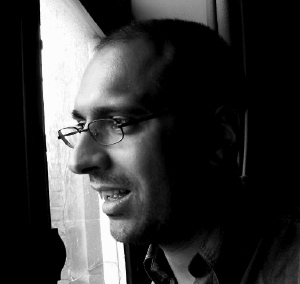 |
Pedro is a
composer/digital artist working in
electroacoustic music, digital media and
installation. He has worked on the
relationship between architecture and music
in creating interactive performance and
installation environments which include a
series of commissioned pieces for soloists
and live-electronics which take as a basis
the interpretation of specific acoustic
spaces.
His electroacoustic music is featured in various CD sets (Sonic Circuits IV, Discontact III, Exploratory Music from Portugal, ARiADA). His work as a pianist and improvisor has been released by Creative Source Recordings and he has collaborated with musicians such as Chris Brown, Mark Applebaum, Carlos Zingaro and Evan Parker. |
| His writings reflect his approach to design and composition by articulating creative practice in a wider understanding of cultural theory. He has published on the relationship between sound and space as manifest in practices such as live electronics and network performance in journals such as Organised Sound, Springer AI & Society, Performance Research and Contemporary Music Review. Pedro has been Visiting Professor at Stanford University (2007) and was Music Chair for the 2008 International Computer Music Conference and for the 2009 Sound and Music Computing conference. He was the first Director of Research at the Sonic Arts Research Centre and is currently Director of Education at the School of Music and Sonic Arts, Queen’s University Belfast. | |
http://www.sarc.qub.ac.uk/~prebelo
ALEXANDER SCHUBERT [GER] >>>
Schubert’s research interest explores cross-genre interfaces between acoustic and electronic music. Musical pieces for audio tapes and the formal notation of compositions for live electronics belong just as much to his work as the design of software-setups and manipulation / design of instruments for an intuitive handling in an improvised context (see "Weapon of Choice”). A permanent focus of his work is the combination of notated and improvised music – both in aesthetics and structure. His technical training is the basis of a differentiated utilisation and individual design of sound synthesis and controllers (e.g. in the installation "A Set of Dots").
Apart from working as a composer and solo musician Schubert is also playing in the ensembles "Schubert-Kettlitz-Schwerdt" (for improvisations solely based on noises) and the electronic trio "Trnn". The formation "Ember" (saxophone, drums, piano, electronic) mainly realises minimal, poly-rhythmic pieces that are a mix of free jazz and contemporary chamber music. Schubert has contributed to a variety of different projects as a musician, composer and programmer (e.g. for the "Wiener Festwochen”, Staatsoper Berlin). Alexander Schubert curates the music festival contemporary electronic music in Leipzig and runs the publishing company "Ahornfelder-Verlag" for experimental audio and book releases.
In 2009 he was awarded with a Bourges residency prize.
His works have been played for example at: ICMC Montreal, SSSP Leicester, Klangwertage Hamburg, ZKM Karlsruhe, SMC Porto, Ahornfelder Leipzig, Bipolar Festival, Blurred Edges Hamburg, Disparate Bodies Festival, Headphone-Festival, Komponistenforum Mittersill, Maribor Slovenia, Hilltown Festival Irland.
http://alexanderschubert.de
JACOB SELLO [GER] >>>
Though focussing on electronic sound creation and production for more than 10 years, he is highly interested in the exiting possibilities that arise from the conjunction of traditional acoustic instruments and state-of-the-art technology. These days he experiments with techniques of algorithmic composition, digital signal-processing and 3d-video-animations. He loves to develop innovative controllers for interactive computermusic and multimedia-performances.
ÁDÁM SISKA [H] >>>
KATHLEEN SUPOVÉ [USA] >>>
The Exploding Piano has become a multimedia experience by using electronics, theatrical elements, vocal rants, performance art, staging, and collaboration with artists from other disciplines. This has taken on several different dimensions. First, Ms. Supové has been commissioning and presenting a new repertory of works for piano and electronics. Secondly, she has been presenting a number of Concert Theater works, most notably the evening-length staged piece for singing/reciting/moving pianist called Jitters, (music by Randall Woolf and texts/directing by Valeria Vasilevski). Furthermore, her Exploding Piano concerts almost always have original monologues and theatrical sketches surrounding the pieces. Kathleen is a featured performer in the Summer 2000 issue of Yale Theater Journal, which is devoted to Concert Theater. In 2001, she was made a Yamaha Artist and is working on a long-term project of commissioning a body of works for Yamaha Disklavier. She has done dance collaborations with The Bill T. Jones/Arnie Zane Dance Company, Susan Marshall and Co., Heidi Latsky, and Nami Yamamoto. Ms. Supové has received commissioning and production grants from Meet The Composer, Mary Flagler Cary Charitable Trust, The Greenwall Foundation, Aaron Copland Fund for Music, and American Composers Forum, among others.
She has appeared with The Lincoln Center Festival, The Philip Glass Ensemble, Bang On a Can Marathon, Music at the Anthology, Composers' Collaborative, Inc., and at many other venues, ranging from concert halls such as Carnegie to theatrical spaces such as The Kitchen to clubs such as The Knitting Factory and The Cutting Room. She is currently an artist-in-residence at The Flea Theater in NYC, where she regularly presents her newest Exploding Piano concerts each season. Recently, she was a featured performer in two prestigious festivals: The Ussachevsky Memorial Festival (Pomona College, Claremont, CA) and the NIME Festival (New Interfaces for Musical Expression) in New York City.
In 2004, Ms. Supové released Infusion on the Koch International Classics label, featuring four contemporary solo works for piano and electronics. It is available through CDBaby, iTunes, and other digital sales outlets. Other recordings can be found on the Tzadik, CRI, Innova, New World, Neuma, Bridge, Centaur, OO, and XI labels.
Besides being a soloist, Kathleen is a member of the art-rock band Dr. Nerve. She also curates Music With A View, a free music + discussion series at The Flea Theater.
http://www.kathleensupove.com/
ANDREA SZIGETVÁRI [H] >>>
In 1989 she was a Fulbright researcher in the USA. First she worked at Brooklyn College with Charles Dodge, later at Stanford University with John Chowning. After returning from the USA in 1990 she funded the Hungarian Computer Music Foundation to help to develop contemporary music life in Hungary.
From the beginning of ‘90-ies she has been the main organizer of the composition and computer music course of the International Bartók Festival, the Short Circuits contemporary music days and from 1998 the Making New Waves contemporary music festival.
Between 1993 and 1995 she developed the musical informatic course’s curriculum at Pécs University and the electronic music curriculum for the Liszt F. Academy of Music in Budapest. 1995 she started to teach musical informatics in the Pécs University and in 1996 electronic music at the Liszt F. Academy of Music in Budapest.
In 2001 she received two "Prix" of the a Bourges Electroacoustic Music Competition in multimedia and sounart categories.
Her creative and reserch work concentrate mainly on the role of the timbre in new music.
http://www.hcmf.hu/
GEORGI SZTOJANOV [H] >>>
He completed his master degree in 2009 at the Lisz Ferenc Academy of Music in Budapest.
His pieces have been performed at IKZE concerts, at Making New Waves Festival, by the Amadinda, 'de ereprijs' orchestra, Angelica choir, Ditta Rohmann, Éva Bodrogi.
He is the composer of the play "Made in China" of the Krétakör Theater.
Recently he is a master student of the Royal Academy of Music of the Hague.
JACOB TV [NL] >>>
Jacob TV is preoccupied with American media and world events and draws raw material from those sources. His work possesses an explosive strength and raw energy combined with extraordinarily intricate architectural design. TV makes superb use of electronics, incorporating sound bytes from political speeches, commercials, interviews, talk shows, TVangelists, and what have you - a colorful mix of high and low culture.
Long queues at the box office for the four-day Jacob TV Festival in Rotterdam in 2001 already attested to the growing popularity of this composer, both in the Netherlands and abroad. His Goldrush Concerto, the Third String Quartet and several of his so-called boombox pieces like Grab It! became hits, and various choreographers have been inspired by his music.
Early in his career, Jacob TV already stood up to what he called the 'washed-out avant garde', which made him a controversial figure in certain circles. He strives to liberate new music from its isolation by employing a direct - at times provocative - idiom that spurns 'the dissonant', which in TV's view reflects a completely devalued means of musical expression. His 'coming-out' as a composer of ultra-tonal, mellifluous music reached its climax with the video oratorio Paradiso. At the Holland Festival 2005, the premiere of ...NOW... for stereophonic orchestra performed by the Royal Concertgebouw Orchestra received standing ovations.
TV is one of the most performed contemporary Dutch composers. In May 2007 a three day JacobTV Festival took place at the Whitney Museum of American Art in New York. Recently bastamusic.com released a box set trilogy containing 11 hours of audio and video.
DAVID WESSEL [USA] >>>
He is particularly interested in live-performance computer music where improvisation plays an essential role. He has collaborated in performance with a variety of improvising composers including Roscoe Mitchell, Steve Coleman, Ushio Torikai, Thomas Buckner, Vinko Globokar, Jin Hi Kim, Shafqat Ali Khan, and Laetitia Sonami has performed throughout the US and Europe.
In computer music performance Wessel favors the enactive approach, which is a performance practices designed from an enactive view of musical perception, cognition, and motor control are described. It emphasizes the role of sensory-motor engagement in musical experience. The enabling elements required for the approach include, rich and precise gestural interfaces, connectivity devices, real-time gesture analysis and mapping software, richly controlled sound synthesis and processing, and the composition of musical worlds in the form of generative algorithms worthy of extensive exploration. These practices in human-instrument symbiosis require a commitment on the part of musicians to develop both refined motor skills and engagement in the development and refinement of real-time software.